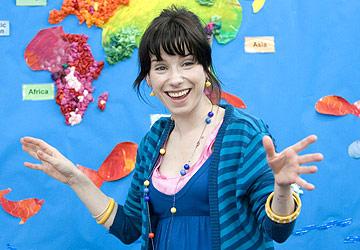
© 2008 NCSU Student Media
courtesy Simon Mein/Miramax Films
Happy-Go-Lucky is a film about the surprising depths of happiness. The story follows Poppy (Sally Hawkins), an optimistic, glass-half-full, goodness-seeking primary school teacher in the heart of London. Poppy is 30-years-old and single, and she couldn’t be happier with the hand that’s been dealt to her. The film chronicles her everyday life experiences as she comes across obstacles posed both by people and by the nature of the human condition on the whole.
Director Mike Leigh is well-known amongst film buffs for incorporating raw social realism into his films and for his somewhat unconventional approach to filmmaking. He captured the banal conflicts of everyday life in everyday people in renowned films like Naked and Vera Drake. In these films, Leigh tended to focus on the darker aspects of human nature, and thus Happy-Go-Lucky is somewhat of a deviation for the director. Poppy is a lighthearted, kind-spirited soul whose pure, happy disposition is a welcome breath of fresh air.
It would have been all too easy for Poppy to come off as naïve, unrealistic and even annoying in her Happy-Go-Lucky endeavors. But through careful character development by both Leigh and Hawkins, Poppy doesn’t come off this way at all. While her disposition is undoubtedly sweet, Poppy shows great intuition and depth as a character. The film’s greatest moments are those of pure, unadulterated happiness where Poppy’s toothy grin will cause even the grouchiest of souls to smile back.
The moments of Poppy’s pure happiness (like her enjoyment of a flamenco dance class) are so strong because Leigh juxtaposes Poppy’s happiness with the sadness of the human condition.
There are several tortured characters that Poppy comes across, particularly Scott (the fabulously creepy Eddie Marsan). Scott is Poppy’s driving instructor, and he is the antithesis to her positive state of mind: bitter, cynical and unhappy. The relationship that Poppy and Scott build has its tense, awkward moments. These moments add to the film’s realism and strength.
Happy-Go-Lucky‘s believability is made possible by great acting. Sally Hawkins portrayal of Poppy is realistic and moving, and it’s hard not to fall in love with her care-free attitude and optimistic approach to life. She is also very relatable, refusing to wear “sensible shoes” to her driving lessons and instead wearing high-heeled boots and stuffing her bra with chicken cutlets when she goes out dancing with her girlfriends.
The relationships in the film are well-developed and believable. Poppy and her flatmate Zoe (Alexis Zegerman) portray a closeness and a friendship that is not that common in average Hollywood films. It’s refreshing to see a genuine relationship between females on the big screen.
There are moments in the film where it feels like you’ve teleported out of the theater and have been plopped right into an intimate family conversation. In one scene, Poppy, Zoe and her younger sister, Suzy, go to visit their very pregnant sister, Helen. The interactions between the sisters reminded me of conversations and fights I’ve had with my own sisters, the intimacy of which makes any bystander feel both uncomfortable and yet ironically, included at the same time.
Leigh captures this realism again when Poppy meets a troubled homeless man one evening. The scene’s strength is in its uncertainty: the viewer understands why Poppy approaches him but doesn’t know how the homeless man will react to her. This moment is characteristic of Leigh’s portrayal of real life, mundane experiences.
Happy-Go-Lucky is a happy film, but it’s also much more than that. Instead of a ditzy, grinning wide-eyed character with no depth, Sally Hawkins’s Poppy shows that even happiness has its depths and its darkness. The film works because it draws you in to Poppy’s world, and begs you to smile and be a part of it.